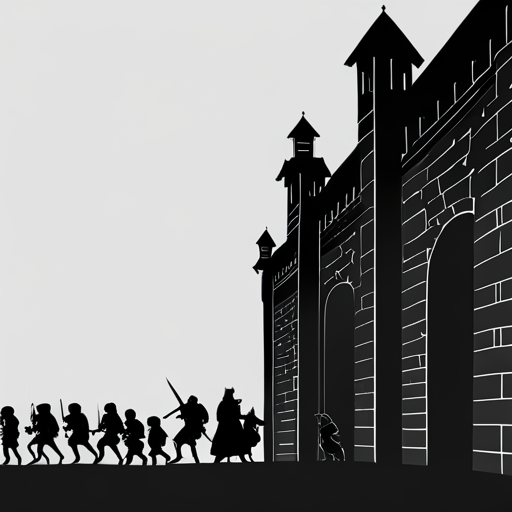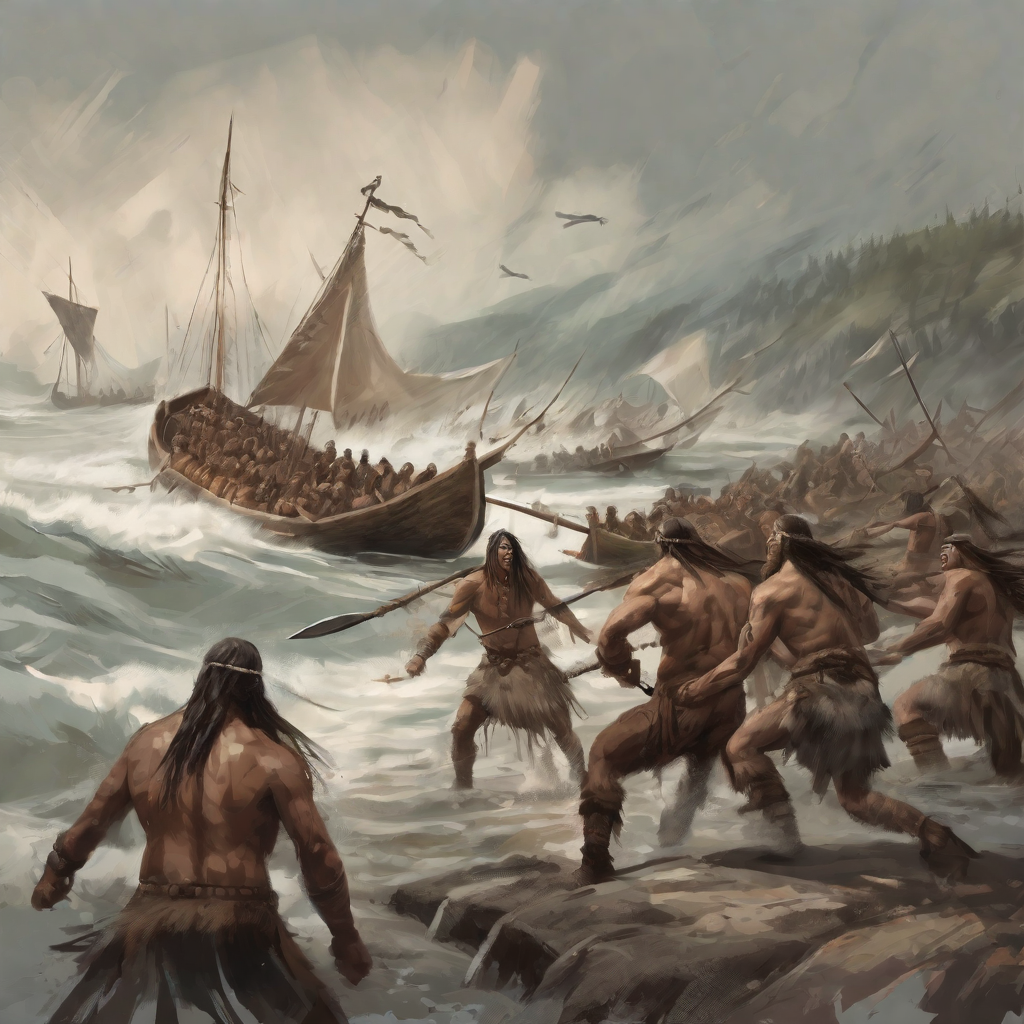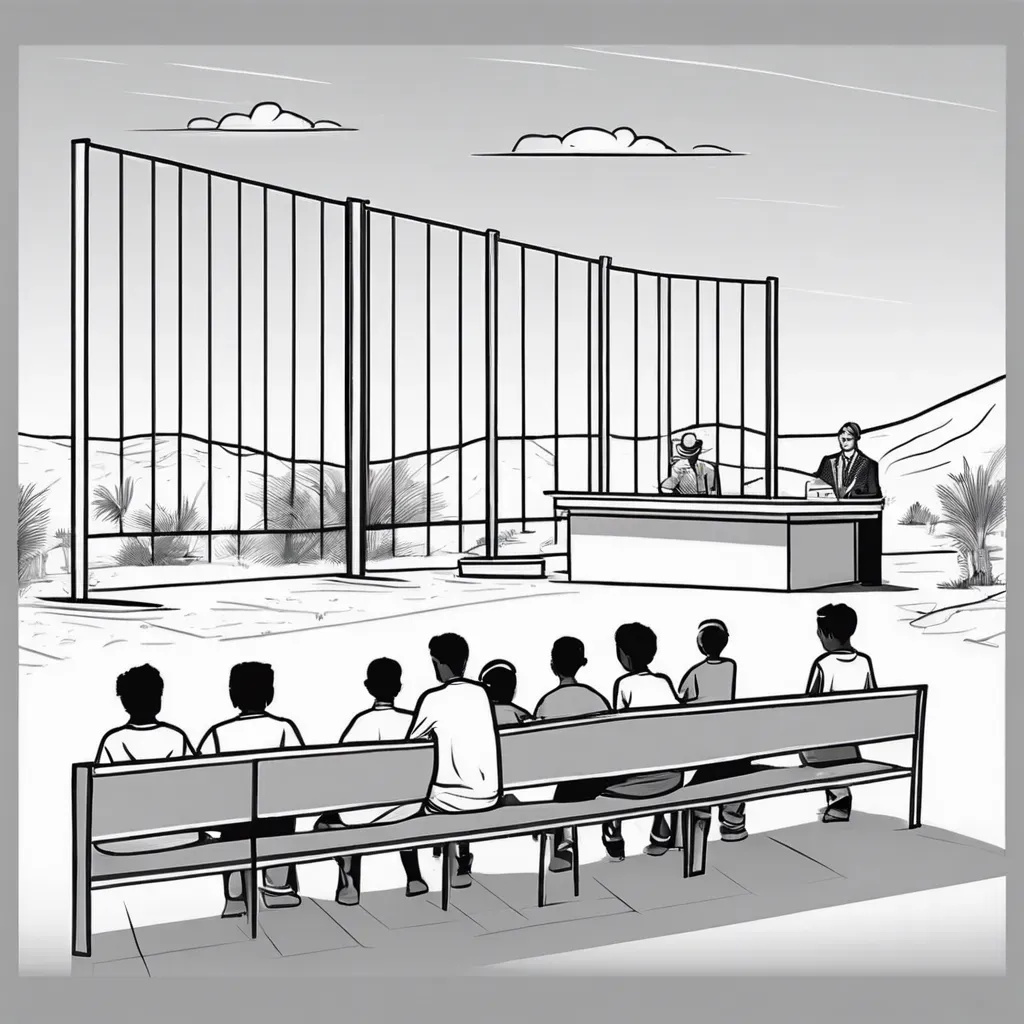Table of Contents
Summary of the long-form article
Here is a summary of the key points from the article:
The article discusses the history of states defying federal authority over immigration issues, from the Civil War era up to the current situation with Texas blocking border patrol agents. It examines the complex economic, humanitarian, security, political, and policy aspects of immigration and border issues.
Some specific events and issues covered:
- April 1861 - Confederate attack on Fort Sumter leads to Civil War
- 1957 - Arkansas governor tries to block school integration, overridden by federal troops
- 2021 - Texas starts Operation Lone Star to block border crossings
- 2024 - Texas National Guard blocks border patrol agents
The article analyzes the motivations behind immigration, including employment, asylum claims, and gaming the lengthy application system to stay in the US, even for ultimately rejected applicants.
It examines policy alternatives like withdrawing from refugee treaties, amending laws, enhancing barriers, and funding more staff and facilities. It notes political obstacles to solutions.
The article uses cost-benefit analysis to compare a border wall approach to increased staffing for processing claims. It finds the wall less effective at deterring immigrants seeking lengthy stays while awaiting decisions.
It concludes that current negotiations seem focused on limited measures like barriers and more policing rather than comprehensively managing asylum requests.
Prepared by claude.ai v.2.1
Very brief history of state defiance of federal authority
April 12, 1861: The newly self-proclaimed sovereign Confederate States of America fires on Fort Sumpter. President Lincoln, in office only since March 4, 1861, calls for the authorized maximum number of militia volunteers. The ensuing Civil War resulted in as many as 750,000 deaths in combat, and from injuries and diseases.
September 4, 1957: Governor Orval Fabus deploys Arkansas National Guard to prevent the Little Rock Nine from entering a whites only high school. On September 24, Eisenhower federalized the Guard and sent the 101st Airborne Division, under authority of the Insurrection Act, to enforce the related court order integrating the school. No shots were necessary. Presumably that deterred the Governor from seeking further office due to the difficulties potentially posed by Section 3 of the 14th Amendment.
June 11, 1963: Alabama Governor George Wallace “stood in the schoolhouse door” to symbolically block the admission of two Black students to university. President Kennedy federalized the Guard and its commanding general tells the Governor to step aside. No shots were necessary. Governor Wallace was undeterred from seeking higher office.
March 9, 2021: Texas Governor Greg Abbot launches Operation Lone Star to deploy the Military Department of the state to assist in blocking or apprehending persons crossing border at points other than official ports of entry. Ongoing litigation concerning the state’s authority is unresolved. Until this month, US authorities had been impeded by Texas-installed barriers including concertina wire. No physical force was applied.
January 12, 2024: Texas National Guard blocks Border Patrol agents, as described in a Heather Cox Richardson post. Unknown if President Biden is weighing the historical precedents.
(Whoa-ooh) I'm stuck on the border
(Whoa-ooh) all I wanted was some peace of mind
Don't you tell me 'bout your law and order (whoa-ooh)
I'm tryna change this water to wine
On the Border, Eagles band members Don Henley, Bernie Leadon and Glenn Frey (1974)
Part of the contemporary conventional wisdom[1] is that «The Border» (Euro-style punctuation used for scare quotes) is an official crisis that will cost Biden the election (and thereby plunge America into the abyss). In recent weeks volumes of crossings have exceeded 10,000, which is more than ten times higher the daily average over the course of the fiscal year ended September 30, 2023.
On the PBS Newshour in December 2023, NPR's Kamera Keith spoke the open political secret: for a generation immigration has been a cherished issue too valuable to do anything about to bring it under some framework capable of managing incoming applicants. The more liberal can beat the more conservative with the label of xenophobic racism. The more conservative can beat the more liberal with the charge of opening the floodgates. What if there were a solution?[2]

We have reduced the childrfen, women and men seeking to stay here to a convenient political rhetoric. That's not the way we used to claim to see huddled masses yearning to breathe free.
«The Border Crises»
- An economic crisis
- A humanitarian crisis
- A security crisis
- A political crisis
- A policy crisisThe aspects differ in kind and degree.
Economic

Prior to the recent increase of persons crossing the border outside of ports of entry (often referred to popularly as “illegal aliens”) for the purpose of claiming asylum, the primary purpose for entry was employment.
“Taking American jobs” is the shorthand for concern that there would be more employment open to US citizens in the absence of competition from illegal aliens.
This is superficially accurate but only under the strong assumption that the jobs filled by those workers would otherwise exist. The most common occupations affected are agricultural harvesting, construction, and commercial kitchens. Employment by unauthorized workers tends to be low-wage and low- to medium skilled. The wages and working conditions are more attractive to the persons filling them compared to the economic opportunities at home. US wages are much higher, even at below legal minimums and living standards and the cost of living home where remittances are sent are much lower than for US citizens. Thus, the North American labor market has a mismatch of supply and demand, which is responsible.
If the imbalance is reduced by excluding non-US workers, acceptable wages and working conditions would be higher, leading to depressed demand from some employers. Those employers would lose the direct advantage of lower-cost labor in terms of payroll costs that do not include tax withholding or employer contributions or benefits. They would also expect greater turnover because of easier mobility as US citizens have potential opportunities at regulatory compliant employers. Employers would also lose power by no longer being able to inform on employees to the immigration authorities, leading to loosening of coercive control.
Humanitarian
Reported deaths crossing the border are on the order of 1-2 per day. Unreported deaths awaiting processing in the US are unknown. These may arise from a combination of lack of shelter and physical debilitation from travel beforehand. Unreported deaths may occur in Mexico either along the border or awaiting admission at ports of entry. A large, but known, number of deaths in_transit is likely much larger than all other deaths.
Security
Smuggling
There has been a long-standing issue with drug smuggling coming from or through Mexico. Essentially all of the bulk smuggling comes concealed through authorized crossings at port of entry. River and open country crossings present logistical difficulties making bulk smuggling difficult. Aside from incidental transport for non-commercial purposes, the smuggling is conducted by large, industrial-scale and sophisticated criminal organizations. These operations have the capacity to penetrate passive barriers, such as walls and wire barriers. Enforcement efforts mostly concentrate at the ports of entry and along interior transportation corridors.
Terrorism
The opening of the 2022-2026 U.S. Border Patrol Strategy identifies terrorism as one of “a myriad of threats” that the agency faces in its opening paragraph. There are no other mentions of the subject in the remainder of the document specific to the subject. The inference that may be drawn is that while undetected crossings by terrorists are a concern there has not been much need identified for special care at the border. At ports of entry, screening against terrorist watch lists is conducted.
Other crime
I haven’t found data on non-drug related alien criminal activity associated with persons entering the country along the border. What data exists do not distinguish those persons from resident aliens or persons lawfully admitted but no longer in authorized status, such as tourists overstaying visa time limits. Approximately 50 million authorized border crossings were reported for 2010.
Political
Electoral
Unauthorized entries are a partisan political issue in the current election cycle. The major parties agree that there is a problem but it centers on the specific issue of persons entering for the purpose of claiming asylum either per se or the burden of placing them in temporary living situations pending consideration of claims. Former President Trump so far is the only major figure using the issue as a vehicle for stoking xenophobia with remarks such as “poisoning our blood.”
Governing
Appropriations for special border related measures are under negotiation as part of the greater budgetary process. Failure to agree may result in the suspension of one or more major functions until new appropriations are made.
Policy
Four major policy alternative to address the Border Crisis exist: withdrawing from treaty obligations to accommodate refugee and asylum application; amending the law to make unauthorized presence an exemption to the general rule of summary deportation without right of appeal; enhanced physical barriers; and adequate funding for staffing and facilities to process asylum applications.
Adoption of any of the approachs require agreement between Congress and the President. Obstacles to agreement are present:
- The Republican party benefits from the continuation of the Border Crisis and would not agree to any alterative aside from the barrier and then only if it were feasible to present that as a victory forced on the Administration.
- The House and Senate are under different party control
- The House has been generally unable to pass legislation of any type
- The House majority is tenuous and internally unstable
Withdrawing from the international regime
US immigration law on the admission of refugees and asylum seekers derives from treaty obligations entered into following World War II, which created tens of millions of what were called “displaced persons.” In it, the US agreed to take refugee applications overseas and asylum applications within national borders. Renouncing those obligations could result in foreign governments doubting our commitment to other treat obligations, notably the North Atlantic Treaty Organization.
Amendment of existing law
The US could repeal the portions of the immigration law dealing to require that all applications for asylum be taken solely in cases of application for admission be accepted solely from persons who enter the country through a port of entry. Current law exempts from immediate deportations persons who “are present” in the country to make asylum application from the general rule. This would tend to reduce unauthorized crossings and encourage entry through authorized locations.
Enhanced barriers
Passive barriers to entry could be strengthened, with the effect of diverting flows to authorized ports of entry. Dealing with persons awaiting processing through the ports of entry would be pushed onto Mexican authorities to take, or not take, measures to shelter and sustain persons waiting to enter.

Funding
An estimated ten-year backlog in asylum hearings is a strong inducement to irregular border crossing. Although immigrants know in advance or learn in transit that there is only very little prospect of success, they see advantage in having provision legal status in the US while their applications are pending. Under US laws this brings with it a host of advantages, including:
- Seeking regular or irregular employment
- Receiving limited public welfare assistance or charitable support
- Freedom to travel throughout the country in documented status
- Possibility to obtain driver licenses
- Potential permanent status for accompanying minors under future Dreamers programs
- Birth right citizenship for any child born while awaiting hearing
The primary reason for attempting to gain these advantage by irregular crossing is to shorten the time before they begin. Essentially, they are cutting in line. They are also gaming the system to gain the advantages for whatever time it takes a decision to be reached. Even if a system of putting such arrivals to the back of the queue personal calculations might turn on whether it is better to await making initial application in detention in the US before being released into the general population than waiting in improvised accommodations in Mexico.
Incidental political considerations
Assuming that the solution has greater partisan political value, the weight assigned to different political props might influence the calculus.
Tough on Crime, Protecting our National borders
Posing with official and vigilante paramilitaries and lends the advantage of being concrete, active, simple to understand and dehumanizing target groups.
People first
Posing with a three-year old unaccompanied minor with only the assistance of an official translator at a hearing before an immigration judge works as a heartwarming illustration of compassion and understanding, but only if the judge is able to elicit sufficient evidence to conclude that the toddler has a well-founded fear of persecution. Watching her walk out of the hearing room in custody bound for transport back to where she came or is assumed to have come is a potential downside.
A Brief History of Immigration
The American Conventional Wisdom℠ has alternated between a triumphalist and catastrophist conception of immigration.

In the Late Pleistocene, the megafauna of North America sadly lacked the political acumen fully to appreciate the implications of the unregulated border incursions across Beringia. The failure led to the extinction of mammoths and many other of the species who were there before. Only the bison managed to survive the artisanal predation of my forefathers initially and they just only escaped the industrial-scale effort to annihilate the bison by my mother's peoples in the 19th century. (No, I don't claim Native American identity, it's just that my paternal haplotype indicates a genetic connection going back over 10,000 years. Who knew?)

The initial wave of immigrants to North America had millennia to prepare for the arrival of newcomers from over the eastern seas. The Beothuk people showed better acumen in throwing back incursions from the illegal landings by Scandinavians ca. 1000. Whatever the other objections the prejudices against the newcomers were based on, it was a sound public health measure, unlike Title 42.

Their neighbors to the south were not so fortunate. For whatever reason, perhaps the tight economic integration promoting rapid and widespread distribution of trade goods, the pandemic of smallpox and childhood diseases often fatal to adults spread rapidly throughout North America. By the time of documented arrivals to the lands of the Massasoit to the Powhatan Renape Nation in the south, disease had reduced population levels to 50-90% of pre-colonial numbers. The consequent social and political dislocation among incumbent nations weakened, generally, their capacity to repel or limit English immigration.
It took the English some time, however, to gain a foothold. The colonial project was tenuous throughout the 1600s and into the 1700s, in large part due to the strategic acumen and political nimbleness of the home team in fending off the intruders through political and military pressure. See Mann, Charles C. 1491 : New Revelations of the Americas before Columbus. New York :Knopf, 2005. Armed conflict continued through at least December 29, 1890 (Wounded Knee), a battle, and a "civil disturbance" at the same site in 1973.

However, by 1751, Benjamin Franklin, secular saint of our very own foundation myth, celebrated what was, to him, a boundless capacity of North America to assimilate population growth. Yet, he did not think any foreigners needed. (“Observations Concerning the Increase of Mankind, Peopling of Countries”, &c., appended to William Clarke, Observations on the Late and Present Conduct of the French with Regard to Their Encroachments upon the British Colonies in North America (Boston: S. Kneeland, 1755))
The Importation of Foreigners into a Country that has as many Inhabitants as the present Employments and Provisions for Subsistence will bear; will be in the End no Increase of People; unless the New Comers have more Industry and Frugality than the Natives, and then they will provide more Subsistence, and increase in the Country; but they will gradually eat the Natives out. Nor is it necessary to bring in Foreigners to fill up any occasional Vacancy in a Country; for such Vacancy (if the Laws are good, § 14, 16) will soon be filled by natural Generation.
What's more, he did not welcome any.
... why should the Palatine Boors be suffered to swarm into our Settlements, and by herding together establish their Language and Manners to the Exclusion of ours? Why should Pennsylvania, founded by the English, become a Colony of Aliens, who will shortly be so numerous as to Germanize us instead of our Anglifying them, and will never adopt our Language or Customs, any more than they can acquire our Complexion.
He was talking of the ethnic group since known as the Pennsylvania Dutch. He would be distressed to learn that among the most common surnames in the contemporary United States were of German origin. When adjusted for Anglicization (Schmitt to Smith, for example), German may since have become the most common. He emphasized his distress regarding complexion.
Why should Pennsylvania, founded by the English, become a Colony of Aliens, who will shortly be so numerous as to Germanize us instead of our Anglifying them, and will never adopt our Language or Customs, any more than they can acquire our Complexion.
Which leads me to add one Remark: That the Number of purely white People in the World is proportionably very small. All Africa is black or tawny. Asia chiefly tawny. America (exclusive of the new Comers) wholly so. And in Europe, the Spaniards, Italians, French, Russians and Swedes, are generally of what we call a swarthy Complexion; as are the Germans also, the Saxons only excepted[3], who with the English, make the principal Body of White People on the Face of the Earth. I could wish their Numbers were increased. And while we are, as I may call it, Scouring our Planet, by clearing America of Woods, and so making this Side of our Globe reflect a brighter Light to the Eyes of Inhabitants in Mars or Venus, why should we in the Sight of Superior Beings, darken its People? why increase the Sons of Africa, by Planting them in America, where we have so fair an Opportunity, by excluding all Blacks and Tawneys, of increasing the lovely White and Red? But perhaps I am partial to the Complexion of my Country, for such Kind of Partiality is natural to Mankind.
In contrast to immigration (people invading us), the bien pensant deploys the word "emigration" to celebrate the hardy pioneer stock, often riding prairie schooners, invading the homeland of someone else.

The American experience has the example of another hegemon to consider. In 376 CE, the Visigoth and Ostrogoth peoples made application to cross the Danube into Roman territory. The Visigoths were being displaced through armed migration by the central Asian population known as the Huns. The Romans granted permission on stipulated terms to the Visigoth but denied the Ostrogoths, apparently for political reasons. Both populations promptly crossed the frontier anyway. The Romans were both prepared and unprepared. They were prepared to exploit the newcomers and unprepared to provide the necessities of life or workable administrative arrangements. Valens, the Roman emperor in the East saw the developing turmoil as a political opportunity to secure his precarious grasp of power. He led a force as ill-trained and ill-equipped as he was himself to lead it and delivered an historic defeat to the Roman military reputation and lost his life in the process.
Later imperial administrations made better arrangements to assimilate the Gothic peoples and the newcomers and incumbents went through the usual process of mutual assimilation in culture.

When low- or no-wage labor has been in high demand, immigration has been popular. When it has been not even internal immigration has been unpopular. The State of California during the Great Depression saw the arrival of thousands of Okies per day. Okies was a slur for midwestern families from not only Oklahoma, but Arkansas, Kansas and other states. The Los Angeles Chief of Police organized port of entry blockades to turn away persons arriving without visible means of support. (Permanent residents of Modoc County who were turned away were able to mobilize political support to run the legalized mob out of the county.) The California attorney general found the action illegal but the governor overruled the finding.
Among the ills claimed of the arrivals of their fellow countrymen, California politicians and interest groups cited
- Public health danger posed by poor sanitation in roadside camps
- Criminals and radicals living on welfare
- The disproportionate burden assumed by the state
And these immigrants were mostly white in the understanding of the law. See United States v. Cartozian, 6 F.2d 919 (D. Or. 1925) (holding that Armenians were comprehended within the meaning the federal law governing eligibility for citizenship as a "free white person," based on the common meaning of the term. Yeminis, on the other hand, were found not to qualify. In re Ahmed Hassan, 48 F. Supp. 843 (E.D. Mich. 1942).)
Political views on immigration are not necessarily informed by racist and xenophobic sentiments but may be influenced strongly by them. A concise summary of major US immigration law A concise summary of US immigration law shows the prevailing wind influences on policy. (For example, it was found necessary to provide for the admission of war brides and their children after World War II.)
The Contemporary Iteration of the Problem—Let's Be Real[4]
The United States faces a different situation than the Romans. Instead of an organized body of people as a negotiation partner, there is a heterogeneous mixture of individuals and families from all over the world. Like the Goths, they are not coming to overthrow existing government but to enjoy peace, stability and economic opportunities. They don't pose the military danger that cancelled Emperor Valens. But one parallel is clear. The US is mishandling the situation by insisting on treating it in the context of short-term political considerations. That is consistent with past practice.
The current state of immigration politics retraces old ground only at much greater volume at a time of administrative unpreparedness rivaling the Romans.
The immigration type currently in controversy involve claims for asylum made in person at ports of entry or by persons who have entered the United States at other locations. Persons making application in their home country or a third nation are classed as refugees. Rather than distinguishing between the two modes by describing one as an "asylee" and the other as "refugee," I will use the latter term to both.
It would be possible to repeal the law permitting application for admission based on refugee status. We could have a debate over "what kind of people are we really?" No more special deal for favored nationalities, such as Cubans, would be one consequence. We would have to withdraw from treaty obligations under the United Nations 1951 Convention and 1967 Protocols relating to the Status of Refugees, to which the United States became a party in 1968.
Next in order of simplicity is to throw money at the problem. The law requires an administrative law judge in a special immigration court to rule on the merits for each application for admission on a case-by-case basis. In a fevered dream of a rocket docket of astonishing efficiency, courts could be staffed to hear applicants around the clock. I've been an ALJ, although not for immigration, and here's how I envision the double-time drill in the form of a hearing transcript. ALJs are actually titled "Immigration Judges," but I'll retain the generic term.
Fake transcript of hearing for asylum application
It's fake but realistic. I used to do this kind of stuff and this is the shortest conceivable hearing I can imagine that satisfies due process under the law.
03:05 2023-12-19
ALJ: Case No. TX-IM5-2410563, in the matter of the application of Lars Jenson.
Ms. Ostrenko: Marie Ostrenko appearing for Mr. Jenson.
Mr. Duberman: Mark Duberman appearing for the United States.
ALJ: How does Mr. Jenson qualify for refugee status?
Duberman: Objection, Jenson was apprehended at a location not authorized by the Attorney General for entry.
ALJ: Mr. Duberman, are you requesting an evidentiary hearing on the circumstances of Mr. Jenson's entry?
Duberman: No, your honor, it's just ...
ALJ: You understand, Mr. Duberman, that I am not a grand jury? And even if I were that I'm not prepared to consider evidence offered by counsel without a witness?
Duberman: Yes, I do.
ALJ: Objection overruled. Ms. Ostrenko, what is the basis for Mr. Jenson's claim.
Ostrenko: Your honor, Mr. Jenson has a well founded fear of religious persecution in his country of origin.
ALJ: Where is that?
Ostrenko: Norway.
ALJ: Norway, I'd have thought that Norway has a reputation for tolerance.
Ostrenko: That is correct, sir. Please let me explain.
ALJ: Proceed.
Ostrenko: Mr. Jenson is of the Lutheran faith, and ...
ALJ: I'll stop you right there. Isn't the Church of Norway an evangelical Lutheran sect that maintains a special status and is financially supported by the state?
Ostrenko: It is, your honor.
ALJ: So explain to me why Mr. Janson has a fear of prosecution. Is he some sort of Lutheran heretic?
Ostrenko: No, your honor. Mr. Janson has experienced harassment from Sunni Muslims, who constitute an appreciable portion of the residents of Oslo where Mr. Janson resided before he fled.
ALJ: And what form did this harassment take?
Ostrenko: Mr. Janson has experienced disapproving looks when he has protested religious observances by Muslims in public.
ALJ: That's it? Private pushback, not official?
Ostrenko: That is correct your honor.
ALJ: Mr. Duberman, does the United States wish to be heard on this?
Duberman: No, your honor, and the United States waives closing argument.
ALJ: Ms. Ostrenko, anything to add?
Ostrenko: No, that completes our case.
ALJ: I find that, as a matter of law, Mr. Janson's fear of religious persecution is not a basis for eligibility for asylum status under applicable law as it arises from non-state actors and there has been no showing that Mr. Janson unsuccessfully availed himself of legal remedy in the courts of Norway. Accordingly, Mr. Janson's application for asylum is hereby denied and he is remanded to the custody of the Immigration and Customs Enforcement for deportation in the ordinary course. Clerk, call the next case.
That's 20 minutes for a case. An ALJ without rest breaks under this regime could handle 24 cases per 8-hour shift. The average daily number of cases for the fiscal year ended September 30, 2023 was approximately 650. To process that number of cases per day would require a staff of 27 ALJs. Approximately 650 ALJs are employed nationwide, yet a backlog of approximately 2 million cases has accrued. That suggests that the average processing time is far longer than 20 minutes and that estimate should be thought of as a unrealistic. To handle the recent peaks of over 10,000 cases would take about 420 ALJs under this unrealistic metric.
The Congressional Research Service, whose job it is to make realistic estimates, thinks that it would take 10 years to work down the backlog if the ALJ corp were increased to 1,350 members. Again, that does not accommodate incoming cases. Extending the arithmetic, if 1,350 ALJs can hear 2 million cases in 10 years, an ALJ can hear and decide approximately 148 cases per year, or, roughly, as many as two a day (not my unrealistic assumption of 24). ALJs have an average case load of 2,844 pending cases. (How many discrete tasks are on your todo list?)
The starting salary for an Immigration Judge in El Paso, Texas, including the locality adjustment, is about $150,000, slightly above the median earnings for all lawyers in 2022, reported by the Bureau of Labor Statistics. The salary would be attractive potentially to public defenders, prosecutors and ALJs for other agencies. Seven years legal experience as a qualified lawyer is required. The estimated recruitment period for rookies is a year and there is the inevitable learning curve to get up to speed. Plus, there are support staff or contractors for clerks and stenographers, among others. A review of usajobs.gov does not show any openings, which may reflect a paucity of authorized positions. El Paso ranked 110th of 150 "best places to live" list published by US News and World Report. One highlight:
El Paso is a great place to live for those who like the outdoors. The metro area's proximity to the Rio Grande provides opportunities to whitewater raft, canoe and fish, …
That assessment may not reflect recently erected access restrictions. El Paso is more urban than Laredo, Nogales and Brownsville and different personal preferences bear.
But in the scheme of things, these are not big bucks, despite Senator Dirkson's Billion-Here-Billion-There™️ classic. Yet, the requirements to keep abreast of applications remain unfunded. You might think "watch what they do, not what they say." Yet the system remains understaffed to work down the backlog, yet alone process the incoming.
Then, there is The Fence. What's not to like? It's big, it's bold and, above all, it's a visible physical manifestation with a clear metric: how many foreigners can get through? China had its Great Wall, which had much the same purpose, which was to channel arrivals through the approved ports of entry. Hadrian's Wall across northern Britannia. And who doesn't like watching the drawbridge rising to seal off the castle?
Yet, the Scots persisted in raiding the Marches, the Mongols successfully passed through the Great Wall to take over China, and Troy's fortifications fell foul of a one-trick pony.
More recently, Israel's militarized border with Gaza failed to hold against the October 7 raids.
Wonkery
So, with a willing suspension of disbelief we set aside the politics of the question and do a straight-up wonk analysis.
- Repealing refugee status is simple but does not necessarily stop attempts to enter, at least immediately.
- Throwing money at the problem has implementation difficulties due to the time to complete and the degree to which it is able to reduce the flow.
Let's compare funding the immigration courts with the border wall from a cost effectiveness perspective, using the wall as the default option. Assume that the barrier can be perfected to the extent of reducing crossings to a trickle by $10 billion in capital costs with, say $500 million in associated operating and maintenance costs. Assume that crossings will be reduced to an average of 100 persons per day, from 1,000 per day.
Alternatively, assume that each person affirmatively or defensively applying for refugee status requires $5,000 for all stages of processing through either deportation or being provided formal permission to remain. Assume that all persons crossing except for those apprehended for reasons of non-immigration related activities average 1,000 per day.
In each case, assume no ramp period and then compare costs in the first year. None of these assumptions are necessarily realistic; they merely serve to illustrate the technocratic cost-benefit approach.
The barrier approach avoids 900 cases per day, or 328,500 cases per year, which would otherwise cost $1.6425 billion to process. From an operating budget standpoint only, neglecting capital costs, the barrier is the cost-effective alternative. However, assuming a 10-year design life for the barrier with straight line depreciation the barrier capital costs will bring costs to $1.5 billion. Within the assumptions, the barrier is still the cost-effective alternative but by relatively little, given the softness of the estimates. It could turn out not to be. The barrier approach leaves 100 cases per day, assumed to cost $182.5 million per year. The barrier does nothing to work down the existing backlog of approximately 1.5 million cases. Using the same $5,000 rule-of-thumb assumption, the backlog represents a cost of $7.5 billion. Long wait times at ports of entry are foreseeable.
Evaluating the tradeoffs not just in terms of crossing but in terms of handling current and backlogged caseload the staffing solution is more cost-effective alternative because the barrier only addresses the new cases, not the backlog of existing cases.
None of this analysis is anything more than an illustration of the usual basis of dialogue between Congress and the Executive Branch for appropriations that have not become heavily politicized. After settling on shared assumptions and identifying differences, the next step would be to consider non-cost consequences.
What might the effect be on the propensity of people to seek refugee status? More assumptions:
- Although there may be some border crossings without intent to seek refugee status, the current difficulties in managing crossings is related to those who do seek refugee status.
- People seeking refugee status prefer authorized residence in the United States to the alternatives of remaining where they are, going somewhere else or attempting to reside here without authorization.
- Like any other major life decision people balance the potential upside (gaining approval) against the potential downside (the time, expense, risk of death or injury on route) before undertaking the attempt.
- People who do attempt have assessed the balance and concluded that the payoff justifies the risks.

The barrier only alternative increases the risk of failure (being unable to cross except at ports of entry). The staffing alternative reduces the benefits of successfully crossing if it reduces time in authorized residence before receiving an adverse decision.
The reduced benefit does not affect all seekers equally. Some few will succeed because they meet the applicable requirements. Others will ultimately be rejected. The former will be able to remain indefinitely while the latter will not. Persons considering attempting should not be assumed to exist in an information vacuum and they take into account information on the factors that determine if requirement will be met. Therefore, some people who arrive know, in advance, that their petitions will ultimately be rejected.
From that perspective, the barrier has no effect at all on the ability to obtain refugee status to allow remaining indefinitely. Neither will the staffing alternative. In either case, petitions will ultimately fail.
If the motivation is authorization to remain in the United States while application is being processed, the alternatives differ greatly. The barrier alternative has no effect on time to process, once begun, because it does nothing to relieve the resource shortage for processing, it only reduces the current volume. The calculus of the non-qualifying applicant is entirely involved in the estimation of the time to process and the benefits of temporary permission to reside in the United States. That brings the matter down to simply how much time do I get to say here while my application is pending?
In other words, incomers will continue to game the system. Surprise! It's the American Way℠, beginning with taxes and on to "no controlling legal authority." So, here's a thought process.
Now OK, right now, I can show up at a port of entry and wait who knows how long to get into the system. Or, I can cross over and get into the system in a day or less. There doesn't appear to be anyway to predict when my petition will be processed. I've heard right away, but I've also heard about a years long backlog.
The Barrier
So, with the new obstacles, I probably can't get across as easily. But I can try my luck and if I can't then I can still go wait in line. Either way, once across I still get my shot at several years before being sent back.
Staffing
Same as now except the clock starts sooner, and I can't estimate whether I get a month or a few years. But with more people involved in processing applications it will not take as long as it does now. It all depends on the details of scheduling that I can't know anything about beforehand. I should probably expect a much shorter maximum time allowed to stay while waiting. So, instead of maybe as long as 10 years like now it could be three years or fewer.
Looking at the situation in that light, the barrier is less effective than the staffing alternative in changing the applicant's assessment compared to the present situation. That is, a barrier alternative may be considered not so much a deterrent as an inconvenience. Its principal effect may be simply to increase congestion at port of entry locations. What level of inconvenience is sufficient to act as a deterrent to using the port of entry is unknown. Part of the problem is the long lead time that may be involved. If travel time in weeks to a port of entry is usual, congestion would have to be maintained at high levels consistently for that factor to figure.
Disjoint Incrementalism in Progress
If there were political will better to manage asylum requests the foregoing is the kind of policy discussion that would take place with the differing assumptions and mix of alternatives that are floated for consideration. The sketchy report of Senate negotiations suggest that the discussion may be proceeding in this style. Given the time constraints (because the discussions are tied to urgent appropriations for Ukraine and Israel), if agreement is reached it is likely to be in the form of a barrier enhancement and funding of more policing.
Footnotes:
- ^1 "It will be convenient to have a name for the ideas which are esteemed at any time for their acceptability, and it should be a term that emphasizes this predictability. I shall refer to these ideas henceforth as the Conventional Wisdom." John Kenneth Galbraith, The Affluent Society (New York: Houghton Mifflin, 1958)"
- ^2
Why this sudden bewilderment, this confusion? (How serious people's faces have become.) Why are the streets and squares emptying so rapidly, everyone going home lost in thought? Because night has fallen and the barbarians haven't come. And some of our men just in from the border say there are no barbarians any longer. Now what's going to happen to us without barbarians? Those people were a kind of solution.
C. P. Cavafy, "Waiting for the Barbarians" from C.P. Cavafy: Collected Poems.- ^3 OK, so Germans aren't swarthy, just tawny, except for the Saxons, perhaps. Rheintöchter welcome, others need not apply.
- ^4
But for now, love, let's be real; I never thought I could feel this way And I've got to say that I just don't get it. I don't know where we went wrong, But the feeling's gone And I just can't get it back.
Gordon Lightfoot, If You Could Read My Mind (1970)
Mascot of the day










